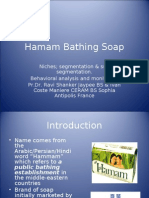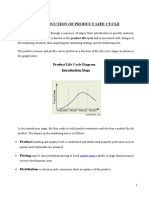Lux (Soap)
Lux (Soap)
Uploaded by
Ayaz MahmoodCopyright:
Available Formats
Lux (Soap)
Lux (Soap)
Uploaded by
Ayaz MahmoodOriginal Description:
Original Title
Copyright
Available Formats
Share this document
Did you find this document useful?
Is this content inappropriate?
Copyright:
Available Formats
Lux (Soap)
Lux (Soap)
Uploaded by
Ayaz MahmoodCopyright:
Available Formats
History of Lux soap
Lux soap first produced in United Kingdom in 1899. It was produced by British company name
Lever Brothers. Lever Brothers was founded in 1885 by William Hesketh Lever and his brother
James. They using glycerin and vegetable oil such as palm oil to manufacture soap called
“Sunlight Soap.” The flaked version of soap called Lux soap. Glycerin was a lucrative byproduct
of the soap making process, and by the end of 1886, Lever brothers also had a glycerin factory.
Lever opened their small office in New York in 1895. The company started selling Sunlight
and Lifebuoy but did not doing well until 1916. Lux soap was first launched in United States in
1916. The Lux trademark was registered in United States in 1900.
Lux soap was launched in India in 1929. The soap's very first advertisement featured actress Leela
Chitnis as its brand ambassador. It was popularly known as 'the beauty soap of film stars.'
From 1930s right through 1970s, Lux soap colors and packaging were altered several times
to reflect fashion trends. In 1958 five colors were made up the range: pink, white, blue, green and
yellow. In 1990s, Lux launching its own range of shower gels, liquid soaps and moisturising bars.
Today, Lux soap is sold in 100 countries and sales achieved 1.0 billion euros in 2005 alone.
History of Lux soup.
Lux is a global brand developed by Unilever. The range of products includes beauty soaps,
shower gels, bath additives, hair shampoos and conditioners. Lux started as “Sunlight
Flakes” laundry soap in 1899.
In 1924, it became the first mass market toilet soap in the world. It is noted as a brand that
pioneered female celebrity endorsements.
As of 2005, Lux revenue is at 1.0 billion euros, with market shares spread out to more than
100 countries across the globe.
Today, Lux is the market leader in several countries
including Pakistan, Brazil, India, Thailand and South Africa[1]
Developed by Unilever, Lux (soap) is now headquartered in Singapore.
Origins and history [edit]
Lux Print ads - Early 20s
The brand was founded by the Lever Brothers (today known as Unilever) in 1899. The name
changed from “Sunlight Flakes” to “Lux” in 1900, a Latin word for “light” and suggestive of
“luxury.”
Lux toilet soap was launched in the United States in 1925 and in the United Kingdom in 1928.
Subsequently, Lux soap has been marketed in several forms, including handwash, shower
gel and cream bath soap.
Since the 1930s, more than 400 of the world’s most famous female celebrities have been
associated with Lux. Reema Khan, Sarah Jessica Parker andAishwarya Rai are some
actresses featured in Lux advertising campaigns.
Lux Early Beginnings
Early beginnings [edit]
Lux’s early advertising campaigns aimed to educate users about its credentials as a laundry
product and appeared in magazines such as Ladies Home Journal. By the early 1920s, it was
a hugely successful brand and in 1924, the Lever Brothers conducted a contest that led them
to a very interesting finding: women were using Lux as toilet soap.
Lux Building beauty soap credentials
Building beauty soap credentials [edit]
Introduced in the US in 1924, Lux became the world’s first mass market toilet soap with the
tagline “made as fine as French Soap”. In the first 2 years of launch, Lux concentrated on
building its beauty soap credentials. Advertisements offered consumers “a beauty soap made
in the French method” at an affordable price, with the promise of smooth skin.
Made with fine-texture, rich in fragrance, and manufactured using a method created in
France, the first Lux toilet soap was sold for 10 cents apiece.
Lux Dainty Girls Win Out
Lux 9 out of 10 stars use Lux
1928–1940: 9 out of 10 stars [edit]
This era saw key launches of LUX in the UK, India, Argentina and Thailand. The brand
concentrated on building its association with the increasingly popular movie world, focusing
more on movie stars and their roles rather than on the product. In 1929, advertising featured
26 of the biggest female stars of the day, creating a huge impact among the movie-loving
target audience. This was followed by Hollywood Directors talking about the importance of
smooth and youthful skin. This pioneered the trend of celebrity product endorsements.
In 1931, Lux launched a campaign with older stars, “I am over 31”. The series of print ads had
stars talking about preserving youthful skin. Lux also launched campaigns featuring interviews
with Stars and Close Ups of Stars, bringing to life the ‘9 out of 10’ idea
Lux Romancing the consumer,Deanna Durbin
40s & 50s: Romancing the consumer [edit]
Using movie star as role models, Lux’s strategy was to build relevance by looking at beauty
through the consumer’s eyes. While still retaining the star element, the focus shifted to the
consumer and the role of the brand in her life.
Advertising commercials showed ordinary looking women with direct references to stars, such
as Deanna Durbin.
Lux Romancing the brand
60s: Romancing the brand [edit]
The 60’s saw a shift in advertising to product stories and the romanticizing of brand through
its “sensorial & emotional” dimensions. This was the era of ‘the film star feeling’ and the
‘Golden Lux’, featuring stars such as Sandra Dee, Diana Rigg and Samantha Eggar.
The bathing ritual, the ‘fantasy’ element that has been the imagery of Lux, was created in this
era. The brand also moved forward with launching LUX in the Middle East, entering a more
conservative market.
70s: Dimensionalizing beauty [edit]
Reflecting the shift in beauty trends in the 70s, the Lux stars stepped down from their
pedestals and were portrayed as multi-faceted women with natural, wholesome beauty that
the ordinary consumer could relate and aspire to. The executions were more of ‘a day in the
life’ of the stars with focus on their ‘natural beauty’. Stars included Brigitte Bardot and Natalie
Wood.
80s: Owning the category space [edit]
Establishing itself as THE beauty soap for stars and beautiful women, the 80s emphasized
the importance of skin care – the first step to beauty. LUX was launched in China at this
time. Sophia Loren, Raquel Welch and Cheryl Ladd were some famous celebrities used
during this time.
In India actresses Hema Malini, Parveen Babi, Madhuri Dixit, endorsed Lux soap.
90s – Early 2000s: Advanced skin benefits [edit]
In the 90s, Lux moved from generic beauty benefits to focus on specific benefits and
transformation. More emphasis on functionality and variant associations with different skin
types as well as mention of ingredients. The communication was far more regional specific
and localized, using stars like Malu Mader and Debora Bloch.
This period launched product brand extensions Shower Cream and Gels and Lux Super Rich
Shampoo in Japan and China.
2000s: Beyond movie stars [edit]
In early 2000, the focus shifted from specific skin benefits to a stronger emotional space. The
brand provided the link between the aspirational role models and real life with the campaign,
‘Lux brings out the star in you’. The benefit was now more than just beauty, it was also about
the confidence that comes from beautiful skin.
In 2005, Lux encouraged women to celebrate and indulge their femininity with the “Play with
Beauty” philosophy, with stars like Aishwarya Rai. The brand also connected with consumers
to take a more ‘active’ stance on beauty.
From 2008, building off the brand’s root strengths, focus has shifted to beauty (vs. femininity),
appealing to consumers’ fantasies and aspirations. Lux believes that ‘beauty is a female
instinct that shouldn’t be denied’ and showcases the pleasure that every woman enjoys from
using her beauty, encapsulating that idea in a simple phrase: Declare your beauty.
Today, LUX products are manufactured at 71 locations with more than 2000 suppliers and
associates providing the raw materials. It has key markets in Pakistan, Brazil, USA, China,
Bangladesh and South Africa, and is a market leader in India (for soap bars), Pakistan, Brazil,
Saudi Arabia (for soap bars), Bangladesh, Thailand and Vietnam.
Case study of Lux
Lux toilet soap was introduced in 1925 as bathroom soap. The name Lux was chosen for its play on the word luxury. Lux has
been marketed in several forms, including bar and flake and liquid (hand wash, shower gel and cream bath soap). Lux soap
was launched in India in 1929. It was branded in India as the beauty soap of film stars.
Lux has been a favourite with generations of users for the experience of sensuous luxurious bathing. Since its launch in
India, Lux has offered a range of soaps in different colours and fragrances.
Lux is truly an international brand that believes in beauty and has always celebrated it. Beauty according to Lux is glamorous,
sophisticated and luxurious. Lux believes in a woman taking pleasure in herself. Lux does not hold a mirror up to its
consumers, it shows the way and it tells stories about the consumer realizing their most beautiful ideal self. It recognizes that
wanting to look and feel beautiful is one of the most fundamental human motivations.
Lux believes that beauty should not be hidden. Lux knows better than any other brand about the beauty of a woman. It knows
that when a woman feels beautiful she looks beautiful.
The personal wash is a highly penetrated market. Consumption lags even in South Asian countries like Indonesia. The
market has been stagnant over the last four years and the low entry barriers have led to intense competition between
national and local brands.
Lux is the largest personal wash brand in the country with a market share of 17%. Three in every five Indian consumers use
Lux during the course of the year. This strong association with the consumers has led to Lux becoming one of the most
trusted brands in the country. No soap brand can claim to be more aspirational for the Indian consumer than Lux – the
beauty soap of film stars. The last three years have seen Lux continue to grow far ahead of the market. A key initiative has
been the launch of Mini Lux – strategically priced to bring it within the reach of 300 million rural consumers. The introduction
of new perfume and in gradient variants addressing the new benefit segment has been the growth driver.
Lux has beauty offerings in two of the four market segments – popular and premium — spanning the needs of varied
consumers. Lux toilet soap in the popular segment has in the past four years offered its consumers a variety of nourishing
ingredients – rose extracts, almond oil, milk cream, fruit extracts and honey which are known to harbour the secrets of
incredibly flawless skin.
At the upper end of the market is the premium range which continues to offer specialized skin care to its consumers in the
form of International Lux – a range of moisturizing deep cleaning, and sunscreen soaps. Keeping in tune with the changing
times it has launched Lux body wash which offers superior bathing pleasure.
After the overwhelming success of the Har Star Lucky Star, promotion to mark the completion, of 75 years in India, Lux
brings to its consumers three unique offers – the Lux Celebration Range.
This range is a set of three exclusive variants – Aromatic Glow, Chocolate Seduction and Lux white Spa body wash
containing exotic ingredients never seen in the Indian market before.
Chocolate Seduction
Rich with cocoa cream and strawberry vitamins, this special offering from Lux nourishes the skin and leaves it looking very
attractive. The chocolate smell and colour is highly enticing and the name Chocolate Seduction builds on this attribute of the
soap.
Aromatic Glow
Containing Lotus extracts and aromatic oils, this special offering from Lux has a beautiful fragrance and makes the skin glow.
This range is being specially offered at the same price as other Lux variants.
Down the ages every leading film star has been a Lux Star. Right from its first Indian star Leela Chitnis, Lux has featured the
likes of Madhubala, Madhuri Dixit, Karisma, Aishwarya and now Kareena, who have all endorsed the goodness of Lux. It is
probably the only brand that has the endorsement of nearly 50 Indian film stars. Even Shah Rukh Khan has endorsed Lux
saying “Aaj mein aapko batenwala hoon meri khubsuratein ka raaz – Lux.”
Across India, the four new variants of lux, in a special 75th year commemorative celebration packs, are endorsed by dream
girl Hema Malini, beautiful Juhi Chawla, stylish Kareena and sensuous Sridevi. They all come together in the new Lux ad
with the first Indian male star Shah Rukh Khan.
At this historic moment, stars are celebrating along with the consumers as they will get to be a part of the action with the Har
Star Lucky Star promotional activity. This will probably go down in history as the only promotional activity where every
consumer is a winner.
more at http://www.citeman.com/14827-case-study-of-lux.html#ixzz2TwfFpj9C
You might also like
- Rosenshines Principles in Action - Tom SherringtonDocument85 pagesRosenshines Principles in Action - Tom Sherringtondrekec pekec100% (2)
- Manual de Inspección de PuentesDocument300 pagesManual de Inspección de PuentesOswaldo Zavala100% (2)
- Business To Business Sales Forcast of DETTOLDocument23 pagesBusiness To Business Sales Forcast of DETTOLmajor8780% (5)
- CHESSDocument3 pagesCHESSJoseph R. Galleno100% (2)
- Apostles The Fathering ServantDocument20 pagesApostles The Fathering ServantJose Humberto Zumarraga Novelo100% (3)
- LuxDocument17 pagesLuxshranjuNo ratings yet
- Lux ProjectDocument17 pagesLux ProjectSneha BhambhaniNo ratings yet
- Introduction To LuxDocument36 pagesIntroduction To Luxkasmshahab67% (3)
- Marketing of Himalaya Herbal Soaps To Rural and SemiDocument5 pagesMarketing of Himalaya Herbal Soaps To Rural and SemiPragati A SubbannavarNo ratings yet
- Lux Facial SoapDocument47 pagesLux Facial SoapDil AfrozNo ratings yet
- Formulation and Evaluation Herbal Antibacterial SoapDocument23 pagesFormulation and Evaluation Herbal Antibacterial Soaprajni thakurNo ratings yet
- Report On Keya Super Beauty SoapDocument18 pagesReport On Keya Super Beauty SoapRafiqul Bari BoneyNo ratings yet
- Lakme Face Wash ProjectDocument12 pagesLakme Face Wash ProjectCuteAngel06No ratings yet
- From Earth To Hair Reviewing Herbal Shampoo BarDocument8 pagesFrom Earth To Hair Reviewing Herbal Shampoo BarDarshana BafnaNo ratings yet
- Camay SoapDocument33 pagesCamay SoapAusaf100% (6)
- How To Revive Margo Soap (SBM Report)Document13 pagesHow To Revive Margo Soap (SBM Report)Seethalakshmi HariharanNo ratings yet
- Lux Soap ProjectDocument3 pagesLux Soap ProjectShubashPoojari50% (2)
- Personal Care Industry Report - SakshamDocument17 pagesPersonal Care Industry Report - SakshamsakshamNo ratings yet
- Distribution ChannelDocument49 pagesDistribution ChannelSaikat GhoshNo ratings yet
- Shakti Project HULDocument18 pagesShakti Project HULthomiscribd100% (1)
- The Relaunch of Camay SoapDocument31 pagesThe Relaunch of Camay SoapSamia Berjees100% (1)
- Channels of Distribution - Ammireddy (Completed)Document82 pagesChannels of Distribution - Ammireddy (Completed)lakshmanlakhsNo ratings yet
- Topical FormulationsDocument5 pagesTopical FormulationsSandeep GargNo ratings yet
- Project Report: "Study On Lux Beauty Soap"Document51 pagesProject Report: "Study On Lux Beauty Soap"singhbba100% (1)
- Lux SoapDocument67 pagesLux SoapPrashant SinghNo ratings yet
- Term Project Report ON "Camay Soap" Reported To: Professor MR - Hammad-Ur-RehmanDocument24 pagesTerm Project Report ON "Camay Soap" Reported To: Professor MR - Hammad-Ur-RehmanhamdanNo ratings yet
- Shampoo BarDocument2 pagesShampoo BarKodag AlgoNo ratings yet
- Soap IndustryDocument79 pagesSoap IndustryGaurav Nathani50% (4)
- A Study On Consumer Satisfaction Towards Lux Siddesh N BDocument3 pagesA Study On Consumer Satisfaction Towards Lux Siddesh N BMadhu RakshaNo ratings yet
- Soap - WikipediaDocument54 pagesSoap - WikipediaArun SinghNo ratings yet
- Project CreamDocument35 pagesProject Creamharsh mainiNo ratings yet
- Chik ShampooDocument36 pagesChik ShampooVenu Gopal100% (2)
- Marketing StrategyDocument21 pagesMarketing StrategyReema NegiNo ratings yet
- Mysore Sandal SoapDocument2 pagesMysore Sandal SoapAmeyaNo ratings yet
- Fair and Lovely b2556Document6 pagesFair and Lovely b2556nelson vargheseNo ratings yet
- Hamam Bathing SoapDocument21 pagesHamam Bathing Soapsandyjbs100% (1)
- LUX Project FullDocument29 pagesLUX Project FullShehzil ArfaNo ratings yet
- Pricing Strategies For Hair OilDocument22 pagesPricing Strategies For Hair OilSatyabrataNayak0% (1)
- Shahnaz HusainDocument14 pagesShahnaz HusainLovejot SinghNo ratings yet
- Hindustan Unilever LimitedDocument36 pagesHindustan Unilever LimitedvishaliNo ratings yet
- Factors Affecting Consumer Buying Behavior For Perfumes.Document32 pagesFactors Affecting Consumer Buying Behavior For Perfumes.Prajwal RahangdaleNo ratings yet
- Baby ShampooDocument8 pagesBaby ShampooRajniBhangaliaNo ratings yet
- Executive SummaryDocument12 pagesExecutive Summaryaleezashiek0% (1)
- Lux Stands For The Promise of Beauty and Glamour As One of IndiaDocument27 pagesLux Stands For The Promise of Beauty and Glamour As One of IndiaPankaj Gupta100% (1)
- Lux (Soap) - Wikipedia PDFDocument21 pagesLux (Soap) - Wikipedia PDFManish ValmikiNo ratings yet
- Origins and HistoryDocument6 pagesOrigins and HistoryHimanshuSharmaNo ratings yet
- Introduction of Lux: Task 1 (A)Document6 pagesIntroduction of Lux: Task 1 (A)Rock AsmighouseNo ratings yet
- LUX Is A Global Brand Developed by Unilever. The Range of Products Includes Beauty SoapsDocument36 pagesLUX Is A Global Brand Developed by Unilever. The Range of Products Includes Beauty Soapspranali pendurkarNo ratings yet
- Marketing Strategy of Lux SoapDocument19 pagesMarketing Strategy of Lux SoapAarti JayakumarNo ratings yet
- Lux: Celebrating BeautyDocument7 pagesLux: Celebrating BeautyjayashreebarikNo ratings yet
- Assignment MarketingDocument12 pagesAssignment MarketingJahid Hossain RupuNo ratings yet
- Brand AuditDocument11 pagesBrand AuditpoomykhanNo ratings yet
- Lux (Soap) : Celebrity EndorsementsDocument5 pagesLux (Soap) : Celebrity EndorsementssakinadollNo ratings yet
- Lux SoapDocument21 pagesLux SoapShrut JabuaniNo ratings yet
- Lux ReportDocument17 pagesLux ReportIsabella MehnazNo ratings yet
- Marketing Project On LuxDocument38 pagesMarketing Project On LuxpriyaNo ratings yet
- Introduction To Lux SoapDocument2 pagesIntroduction To Lux SoapBeerla RajenderNo ratings yet
- Introduction To LuxDocument36 pagesIntroduction To LuxMehedi HasanNo ratings yet
- 17 PDFDocument2 pages17 PDFschizitNo ratings yet
- LUX - An HUL BrandDocument22 pagesLUX - An HUL Brandaditig2275% (4)
- Brand Positioning Lux Soap in BangladeshDocument14 pagesBrand Positioning Lux Soap in BangladeshPranoy SahaNo ratings yet
- Lux DifferentiationDocument2 pagesLux DifferentiationAshish SinghNo ratings yet
- Project On LUX Soap IntroductionDocument3 pagesProject On LUX Soap Introductionfatima shoukat100% (2)
- Projectofvisem Conversion Gate01Document51 pagesProjectofvisem Conversion Gate01imran shaikNo ratings yet
- Initial Interview Questionnaire: Finance and Etc) ? List Three in Order of PriorityDocument2 pagesInitial Interview Questionnaire: Finance and Etc) ? List Three in Order of PriorityAyaz MahmoodNo ratings yet
- The Impact of The Charismatic Leader: Raising Productivity & ProfitabilityDocument44 pagesThe Impact of The Charismatic Leader: Raising Productivity & ProfitabilityAyaz MahmoodNo ratings yet
- VIS Report FialDocument16 pagesVIS Report FialAyaz MahmoodNo ratings yet
- Likert Scale QuestionnaireDocument2 pagesLikert Scale QuestionnaireAyaz Mahmood0% (2)
- Area For Improvement: Lack of Implementation of Promotion PolicyDocument5 pagesArea For Improvement: Lack of Implementation of Promotion PolicyAyaz MahmoodNo ratings yet
- Recall The Flows of Funds and Decisions Important To The Financial ManagerDocument27 pagesRecall The Flows of Funds and Decisions Important To The Financial ManagerAyaz MahmoodNo ratings yet
- 2nd DocumentDocument1 page2nd DocumentAyaz MahmoodNo ratings yet
- Average Costing Method Has The Following Main AdvantagesDocument2 pagesAverage Costing Method Has The Following Main AdvantagesAyaz MahmoodNo ratings yet
- Who Good Faith-Good Faith Good Faith-Bad Faith Bad Faith-Good FaithDocument1 pageWho Good Faith-Good Faith Good Faith-Bad Faith Bad Faith-Good FaithJohn Marti MaghopoyNo ratings yet
- 2023 Daniel T Warren V Gary A Dickson Et Al - Responding PapersDocument29 pages2023 Daniel T Warren V Gary A Dickson Et Al - Responding PapersDaniel T. WarrenNo ratings yet
- Palay Inc Vs ClaveDocument2 pagesPalay Inc Vs ClaveBelzer ResurreccionNo ratings yet
- Brochure Simatic Wincc v72 enDocument8 pagesBrochure Simatic Wincc v72 enjeanfmirandaNo ratings yet
- JTAC EMEA Overview 2019-PartnersDocument8 pagesJTAC EMEA Overview 2019-PartnersBenNo ratings yet
- Practice Test 6Document7 pagesPractice Test 6ngocha.avk33aNo ratings yet
- A C G D M: Tom's PerspectivesDocument3 pagesA C G D M: Tom's PerspectivesCardician7No ratings yet
- High Flow Nasal Oxygen PDFDocument26 pagesHigh Flow Nasal Oxygen PDFGulshan kumarNo ratings yet
- El-Fekkak, Badr - Justice As Divine Providence in Al-FarabiDocument20 pagesEl-Fekkak, Badr - Justice As Divine Providence in Al-FarabiJonathan DubéNo ratings yet
- Overflow12 PDFDocument11 pagesOverflow12 PDFTayyaba NafeesNo ratings yet
- Greek Mythology Posters FREEBIEDocument6 pagesGreek Mythology Posters FREEBIEDavidNo ratings yet
- Levi's & Calvin KleinDocument19 pagesLevi's & Calvin Kleinzayana kadeejaNo ratings yet
- Corporate Sales Account Executive in CO Resume Aaron SmithDocument2 pagesCorporate Sales Account Executive in CO Resume Aaron SmithAaronSmith2No ratings yet
- Bertrand Russell - What I Have Lived ForDocument2 pagesBertrand Russell - What I Have Lived Formetalover36100% (1)
- Study Unit Eight Activity Measures and FinancingDocument15 pagesStudy Unit Eight Activity Measures and FinancingPaul LteifNo ratings yet
- Makalah Barir Faqih-Danar Andria SMA Trensains Muhammadiyah Sragen S Nas2021Document5 pagesMakalah Barir Faqih-Danar Andria SMA Trensains Muhammadiyah Sragen S Nas2021Muhammad Barir Faqih HermawanNo ratings yet
- BI103 Lab 06 - Phylum MolluscaDocument78 pagesBI103 Lab 06 - Phylum MolluscaJalu PrianggodoNo ratings yet
- Operation & Maintenance Manual: PW170ESDocument266 pagesOperation & Maintenance Manual: PW170ESЭрнест Бекиров100% (1)
- SxsDocument12 pagesSxsArvin BabuNo ratings yet
- Zamboanga City: Orgullo de MindanaoDocument35 pagesZamboanga City: Orgullo de MindanaoAngelo Mariano De Asis100% (1)
- New PDIC Claim FormDocument3 pagesNew PDIC Claim FormArun PrakashNo ratings yet
- AAIR BOA - Complete File - November 23Document54 pagesAAIR BOA - Complete File - November 23Rex LimNo ratings yet
- Moc U Medjunarodnim Odnosima - 09 - 10Document103 pagesMoc U Medjunarodnim Odnosima - 09 - 10Nedeljkovic Ex Nikolic AnaNo ratings yet
- w93c26 PDF EngDocument20 pagesw93c26 PDF EngParalela 91 DigitalNo ratings yet
- SIEMENS Analysis of Financial StatementDocument16 pagesSIEMENS Analysis of Financial StatementNeelofar Saeed100% (1)
- City Identity EssayDocument8 pagesCity Identity EssayCut Rini Nabila PutriNo ratings yet

































































































